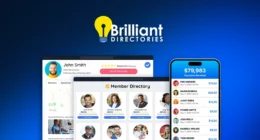Task management software helps small businesses track projects, delegate work, and meet deadlines more effectively. Popular options like Trello and Asana offer features including real-time tracking, automated reminders, and team collaboration tools at budget-friendly prices. These systems centralize workflows, reduce miscommunication, and boost productivity through smart scheduling and visualization tools. Small businesses can typically start with free versions or low-cost subscriptions. Understanding key features and implementation strategies will maximize the software’s impact on business growth.
Quick Overview
- Task management software helps small businesses automate workflows, track deadlines, and improve team collaboration through centralized platforms.
- Popular solutions like Trello and Plaky offer budget-friendly options with core features suitable for basic small business needs.
- Essential features include real-time tracking, automation tools, visualization boards, and integration capabilities with existing business systems.
- Most task management tools provide free tiers or low-cost subscriptions, making them accessible for small business budgets.
- Choosing the right software depends on budget constraints, required features, ease of use, and potential for scalability.
Why Your Small Business Needs Task Management Software

Five compelling reasons drive small businesses to adopt task management software in today’s fast-paced work environment. First, these tools optimize productivity by ensuring efficient task allocation and preventing deadline lapses through automated reminders.
Second, they enhance organization by providing a centralized platform where teams can track all tasks and deadlines in one place. Third, collaboration improves substantially as team members share task details and communicate effectively, regardless of physical location.
Fourth, better time management emerges through built-in tracking features and smart scheduling tools that help prioritize work effectively. Finally, these systems promote cost efficiency by automating repetitive tasks and improving resource allocation. Modern solutions like ClickUp offer multiple task views that allow teams to visualize their work in ways that best suit their needs.
For small businesses with limited resources, these benefits translate into streamlined operations, reduced errors, and improved overall performance.
Essential Features to Look for in Task Management Tools
Selecting the right task management tools requires careful consideration of key features that align with small business needs. The most essential capabilities include real-time tracking, which enables immediate visibility of project progress and team performance, and robust automation features that streamline repetitive tasks and notifications.
Effective task management solutions should offer clear visualization tools, such as Kanban boards and Gantt charts, making it easy to prioritize work and identify bottlenecks. Integration capabilities with existing business tools like email and CRM systems are pivotal for maintaining seamless workflows. Additionally, built-in collaboration features, including in-app messaging and file sharing, help teams work together efficiently while maintaining proper documentation of task updates and changes. Implementing comprehensive workload planning and calendars helps organizations optimize their operational efficiency and resource allocation. These core functionalities make certain that small businesses can manage their operations effectively while scaling their processes.
Top Software Solutions for Small Business Teams

The modern marketplace offers small business teams an abundance of task management solutions, each designed to address specific operational needs and team dynamics.
Several top-rated platforms stand out for their versatility and value, with many offering free or low-cost entry points for growing organizations. Power-Ups and automations enhance productivity by streamlining repetitive tasks and enabling seamless third-party integrations.
Popular solutions include:
- Plaky and Trello for teams seeking intuitive, budget-friendly options
- Asana and monday.com for businesses requiring advanced automation features
- Smartsheet for companies heavily invested in spreadsheet-based workflows
- Zoho Projects for extensive integration capabilities
These platforms typically provide essential features like task tracking, team collaboration, and project timeline management. Cost-effective options start as low as $3.99 per user monthly, with many tools offering free tiers that include core functionality for small teams getting started with digital task management.
Maximizing Team Productivity With Task Management Systems
Successfully maximizing team productivity requires a strategic approach to task management systems, combining smart prioritization with streamlined workflows. Teams utilizing effective prioritization methods are 1.4 times more likely to outperform their peers, while structured task management reduces burnout and improves focus. The emphasis on employee well-being has become essential for maintaining sustainable team performance in modern work environments.
| Feature | Benefit | Impact |
|---|---|---|
| Priority Setting | 38% better goal achievement | Reduced stress |
| Real-time Updates | Enhanced collaboration | Fewer mistakes |
| Analytics Tools | Data-driven decisions | Higher efficiency |
Modern task management platforms offer automated features that streamline operations and scale with business growth. These systems provide valuable insights through analytics, tracking metrics like completion rates and team efficiency. By implementing centralized task management, teams can distribute workloads evenly, maintain clear communication channels, and leverage automation to reduce repetitive tasks—ultimately creating a more productive work environment.
Choosing the Right Software for Your Business Size and Budget

Choosing task management software represents a critical decision point for small businesses, where the right solution can dramatically streamline operations while the wrong choice can waste valuable resources. When evaluating options, businesses should weigh their specific needs, team size, and budget constraints.
Key factors to weigh when selecting task management software:
- Budget alignment with subscription plans and total ownership costs
- Essential features that match workflow requirements
- User-friendly interface with minimal learning curve
- Integration capabilities with existing business tools
For micro-teams and startups, free platforms like Trello offer basic functionality without financial commitment. Growing businesses might benefit from scalable solutions like Asana or Monday.com, which provide robust features for team collaboration. Modern task management platforms offer automated workflows to help teams eliminate repetitive tasks and increase efficiency. Industry-specific tools, such as FunctionFox for creative teams, offer targeted solutions that address unique workflow requirements.
Future-Proofing Your Business With Modern Task Management
In today’s rapidly evolving business landscape, future-proofing task management systems has become essential for small business survival and growth. Modern solutions offer powerful analytics to track performance and continuously optimize workflows, ensuring businesses stay competitive and efficient. Machine learning algorithms now autonomously analyze and prioritize tasks to maximize team productivity.
These systems embrace a product-centric mindset, incorporating regular updates and customer feedback to maintain long-term adaptability. Key future-proofing features include:
- Flexible integrations with evolving business tools
- Regular software updates for technology compatibility
- Performance analytics for workflow optimization
- Cloud-based accessibility for remote operations
- Scalable solutions that grow with the business
Frequently Asked Questions
How Long Does It Typically Take to Migrate Existing Tasks to New Software?
Task migration typically takes between a few hours to several weeks, depending on various factors. Small to medium-sized task databases usually require 1-2 days, while complex migrations with dependencies may extend to weeks.
The timeline depends heavily on data volume, system compatibility, and available migration tools. Using automated solutions can substantially reduce the process, while manual transfers take longer. Pre-migration cleanup and proper planning help optimize the timeline.
Can Task Management Software Track Employee Productivity Without Appearing Too Intrusive?
Modern task management software can track productivity respectfully by focusing on project milestones and completion rates rather than invasive monitoring. Features like automatic time tracking, customizable dashboards, and voluntary self-reporting tools help maintain employee privacy while providing useful metrics.
The key is implementing these tools transparently, communicating their purpose clearly, and using data to support employee growth rather than micromanagement. This approach maintains trust while improving workflow efficiency.
What Happens to Stored Task Data if the Software Company Goes Bankrupt?
When a software company declares bankruptcy, stored task data faces several risks. The data may become part of the company’s assets, potentially being sold or transferred to new owners. Users might lose access to their information during bankruptcy proceedings. To protect against this, businesses should:
- Maintain regular local backups
- Review service agreements for data ownership terms
- Consider using providers with data escrow agreements
- Have a backup software solution ready for quick migration
Are There Industry-Specific Task Management Solutions for Specialized Business Needs?
Just as a master craftsman needs specialized tools for unique projects, different industries require tailored task management solutions.
The marketplace offers dedicated software across various sectors: Healthcare providers benefit from patient-centric systems like CareCloud Central, construction teams utilize field-focused tools like Procore, legal professionals rely on case management platforms like Clio, and retailers streamline operations with integrated solutions like Shopify Flow. Each industry has purpose-built options addressing its specific workflows.
How Often Should Small Businesses Conduct Task Management Software Training Sessions?
Small businesses should conduct task management software training sessions quarterly as a baseline, with additional sessions when major updates occur. The training schedule should factor in employee turnover, software complexity, and team size.
Monthly micro-training sessions of 15-30 minutes can supplement quarterly meetings, keeping skills fresh without disrupting workflows. For new employees, immediate onboarding training is essential, followed by integration into the regular training cycle.
Conclusion
Like a well-oiled machine, task management software keeps small business operations running smoothly in today’s digital landscape. By carefully selecting the right solution, teams can transform scattered to-do lists into streamlined workflows that drive results. Whether managing five employees or fifty, these powerful tools hold the key to enhanced productivity, clearer communication, and sustainable growth. The future of small business success lies in embracing these digital solutions.








